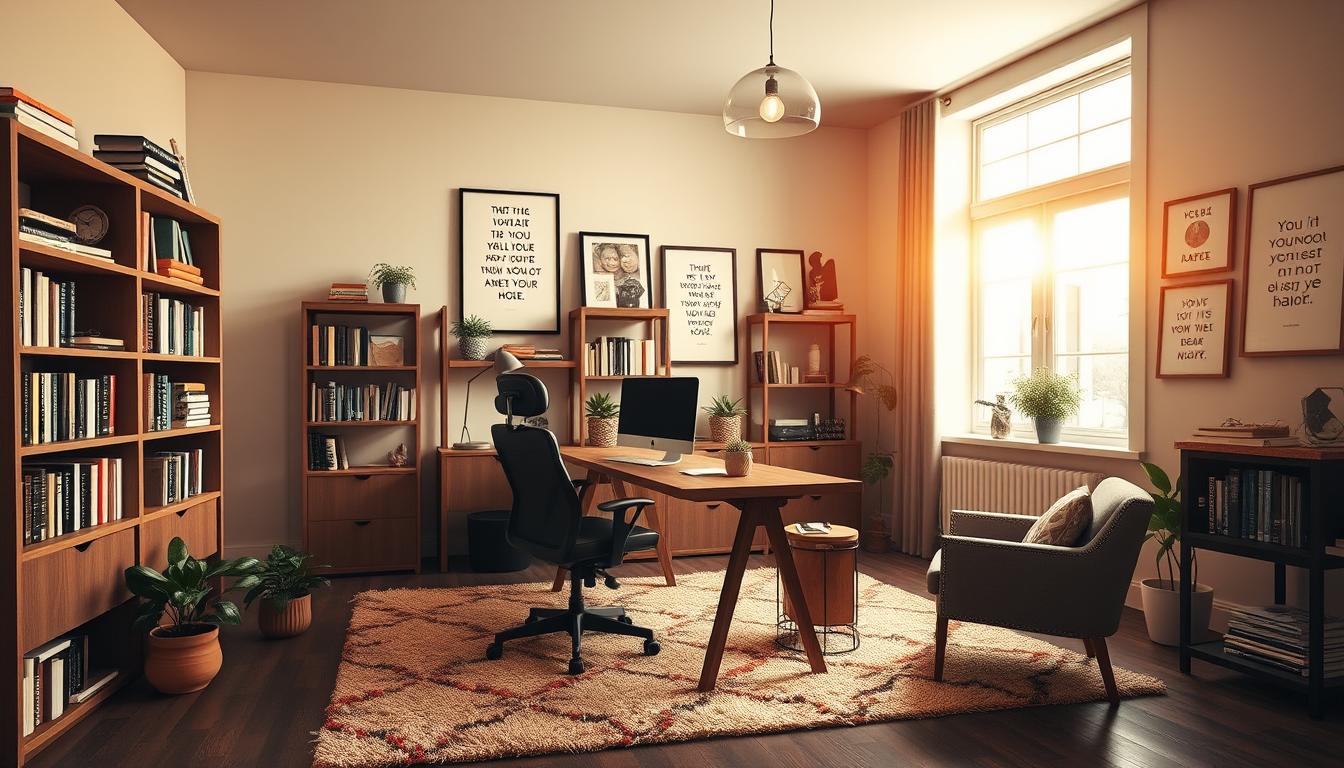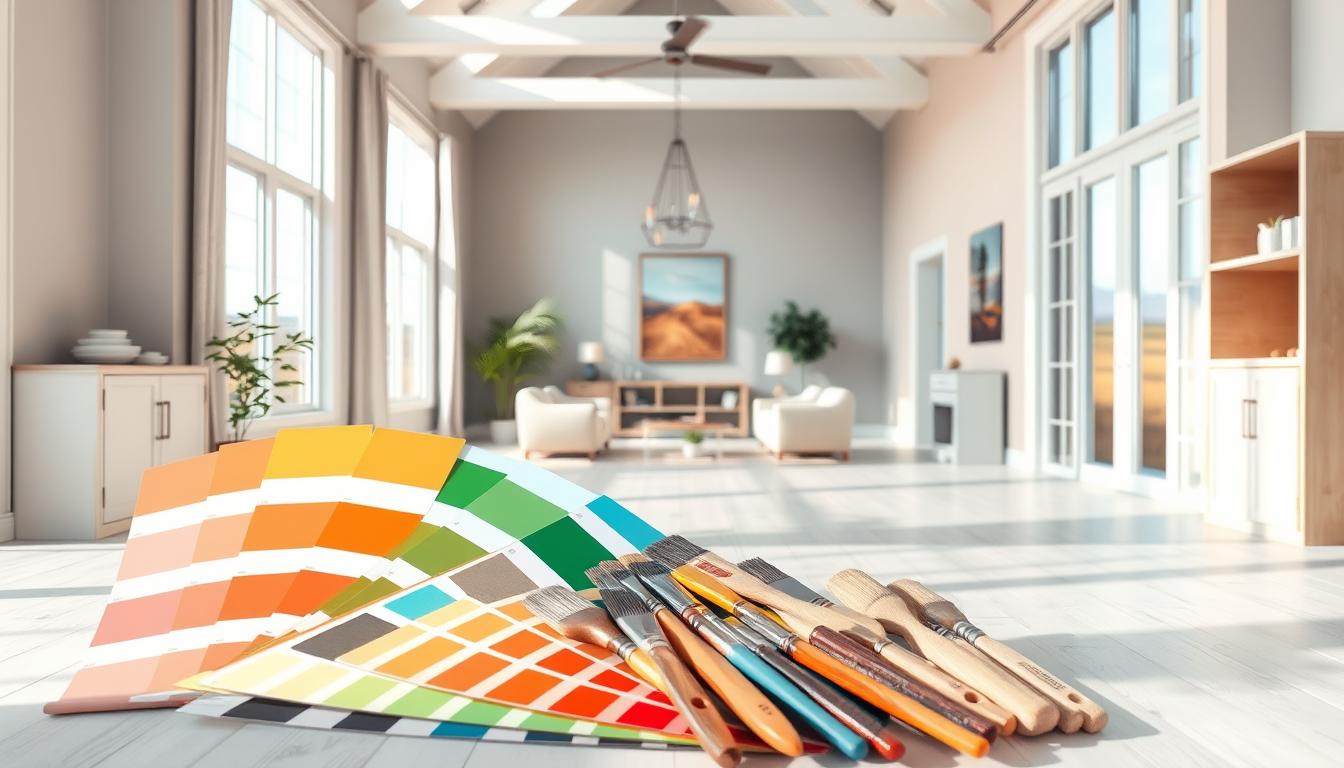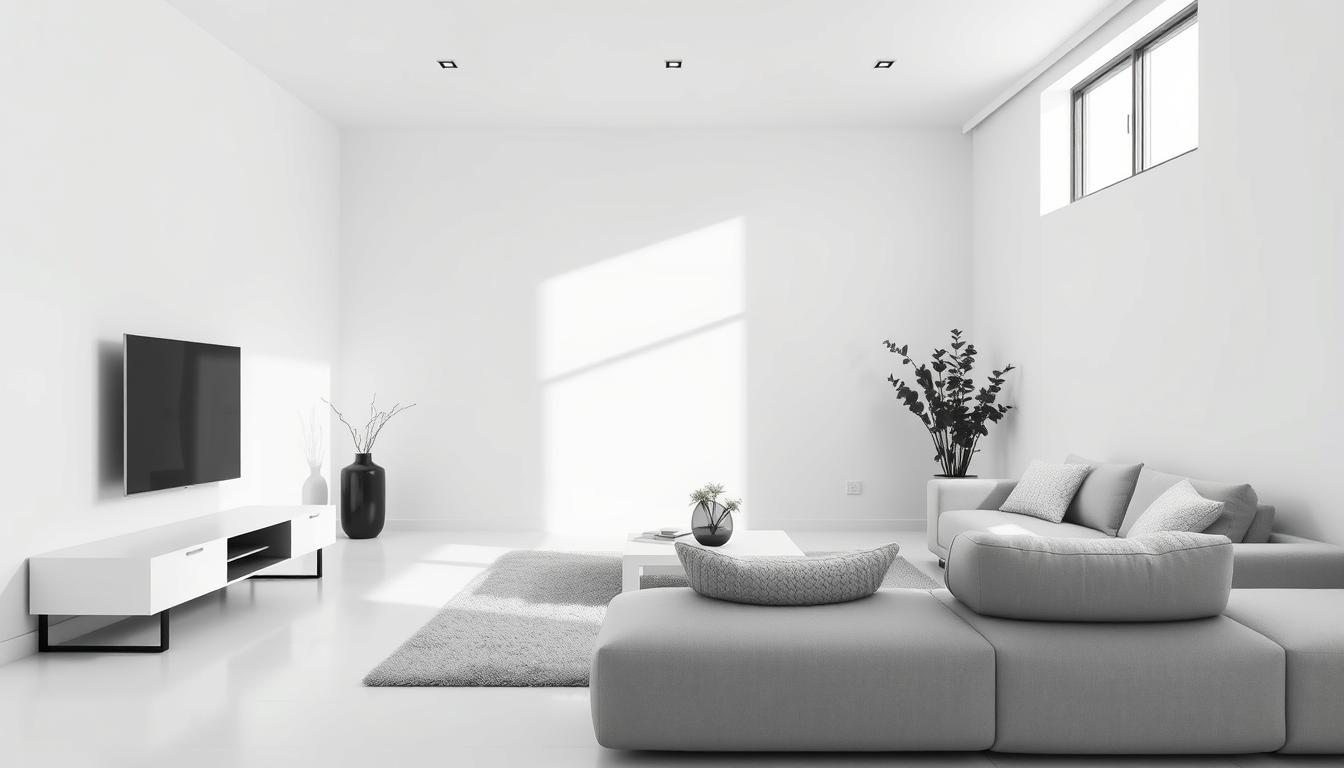Did you know a well-designed workspace can increase productivity by up to 20%? With more people working from home, having a good workspace is key.
We know how important a comfy and inspiring workspace is. That’s why we’re sharing tips on making a home office interior that boosts your productivity and creativity.
Key Takeaways
- Optimize your workspace for maximum productivity
- Discover inspiring home office decor ideas to boost creativity
- Learn how to create a functional and stylish workspace
- Maximize your comfort and reduce distractions
- Create a workspace that reflects your personal style
Importance of a Functional Home Office Interior
A home office that’s both comfy and stylish can really boost your work efficiency. We’ll look at how to find this perfect balance in your workspace.
Boosting Productivity with the Right Design
The design of your home office is key to your productivity. A modern home office design includes features that keep you focused and away from distractions. For example, a clean and organized workspace helps you concentrate better.
Think about your office layout to improve productivity. An open layout can spark creativity. But, a separate area can help with tasks that need deep focus.
Enhancing Comfort for Long Hours
Comfort is vital in a good home office. When you’re comfy, you can work for long hours without getting tired. A good ergonomic chair and desk are essential. They support your body, reducing strain and injury risks.
Adding things like plants or a window with a view can also boost comfort and job happiness.
Balancing Aesthetics and Functionality
It’s important to mix beauty with function in your home office. Home office organization tips help you do this. They make sure your space looks good and works well.
| Design Element | Aesthetic Value | Functional Value |
|---|---|---|
| Ergonomic Furniture | Modern look, sleek designs | Supports comfort, reduces fatigue |
| Color Scheme | Enhances mood, creates ambiance | Influences productivity, focus |
| Storage Solutions | Conceals clutter, maintains cleanliness | Organizes workspace, improves efficiency |
By focusing on both looks and function, you can make a workspace that’s pleasing and productive.
Choosing the Right Location in Your Home
Finding the perfect spot for your home office is key to being efficient and happy at work. Several important factors need to be considered.
Assessing Quiet Areas for Focus
A quiet spot is crucial for focusing. Look for areas away from busy spots and noise, like the kitchen or living room. For small spaces, think about using noise-cancelling panels or soundproofing to cut down on distractions.
Evaluating Natural Light Sources
Natural light can make you feel better and work better. Choose a spot with lots of natural light, but watch out for glare on your screen. A window spot is great, as long as you can adjust the light. This is a big part of a creative workspace design.
Space Considerations for Equipment
Make sure the spot has room for your gear and furniture. Think about how you’ll arrange everything for your work. Here are some tips:
- Measure the space and plan your furniture layout.
- Think about how you’ll move around and get to your equipment.
- Save some room for future changes or additions.
By carefully thinking about these points, you can make a home office that works well and feels good. It will help you succeed while working from home.
Essential Furniture for a Home Office
Choosing the right furniture for your home office is key to staying productive and comfortable. The right pieces can make your work better, while the wrong ones can make it harder.
Selecting an Ergonomic Desk and Chair
An ergonomic desk and chair are must-haves for a comfy home office. An ergonomic chair supports your back, helping you stay in good posture and avoiding back pain. Look for a chair that adjusts height and has lumbar support.
An ergonomic desk should let you work with your elbows at 90 degrees and your monitor at eye level. Think about getting a sit-stand desk or a convertible desk. These let you switch between sitting and standing, which is healthier.
Incorporating Storage Solutions
A clean workspace helps you focus. Use storage solutions like filing cabinets, shelves, and desk organizers to keep things tidy. Think about what you need to store based on your work.
- Use vertical space with wall-mounted shelves.
- Opt for a desk with built-in storage.
- Invest in a file organizer for your most frequently used documents.
Choosing Multi-functional Furniture
In small home offices, multi-functional furniture is a big help. Items like storage ottomans or desks with built-in bookshelves save space and add function.
| Furniture Piece | Functionality | Space-saving Benefit |
|---|---|---|
| Storage Ottoman | Storage and Seating | Replaces separate storage and seating units |
| Desk with Bookshelf | Work Surface and Storage | Combines workspace and storage in one unit |
| Wall-mounted Shelves | Storage | Frees up floor space |
By picking furniture that looks good and works well, you can make a home office that boosts your productivity and comfort. The goal is to find a balance between looks and function.
The Role of Color in Your Home Office
The color of your home office can really impact how well you work. Colors can make us feel certain ways, spark creativity, and even affect our health. By knowing how colors work, you can make your office look good and help you work better.
Understanding Color Psychology
Color psychology is about how colors affect us. Different colors can make us feel calm or energized. For example, blue can make you feel calm and trustful, which is great for focusing. But, yellow can make you feel creative and happy, but too much can make you feel frustrated.
Knowing how colors affect us helps you pick the right colors for your office. Think about what kind of work you do and what mood you want to create.
Selecting the Right Palette
When picking colors for your office, think about your work and what you like. If you do creative work, colors like orange or green might help. For tasks that need focus, calm colors like light blue or neutral tones are better.
Also, think about the light in your office. It changes how colors look. Try paint samples or use visualizers to pick the right colors.
Tips for Painting or Wallpapering
After picking your colors, it’s time to apply them. Start with a primer for even color. Use a semi-gloss paint for easy cleaning. For wallpaper, pick a design that fits your style and doesn’t clutter the space.
Remember, you want a space that works well and looks good. Feel free to try different colors and patterns until you find the perfect mix for your office. This will help you create a modern and productive space.
Lighting Strategies for a Productive Workspace
Good lighting is key for a home office that’s both productive and comfy. It affects our mood, energy, and focus. We’ll look at how different lights can change your workspace.
Importance of Natural Light
Natural light is the best for any workspace. It saves energy and has health perks. It boosts vitamin D, mood, and productivity. Place your desk near a window for the most natural light.
Benefits of Natural Light:
- Improves mood and reduces stress
- Enhances productivity and focus
- Regulates circadian rhythms
Types of Artificial Lighting
Artificial light is needed when natural light isn’t enough. There are many types, each with its own benefits. Ambient light covers the whole area, task light focuses on work areas, and accent light highlights features or sets a mood.
Choosing the Right Artificial Lighting:
- Ambient Lighting: Use ceiling fixtures or table lamps for overall light.
- Task Lighting: Desk lamps are great for focused light on your work.
- Accent Lighting: Floor lamps or picture lights create a cozy feel.
Layering Light for Versatility
Layering different lights makes your home office versatile. It lets you change the light to fit your needs. Mixing natural and artificial light creates a flexible and beautiful workspace.
To layer light well, follow these tips:
- Mix light sources to avoid harsh shadows and overly bright spots.
- Use dimmers to control light intensity.
- Position lights to avoid glare on screens and surfaces.
Personalizing Your Home Office Space
Personalizing your home office is more than just making it look good. It’s about making a space that boosts creativity and focus. A space tailored to you can really improve your work life.
Adding Personal Touches
Adding personal touches makes your home office feel more welcoming. Think about using family photos, heirlooms, or collectibles that show your style. Stylish home office furniture that fits your taste also adds to the charm.
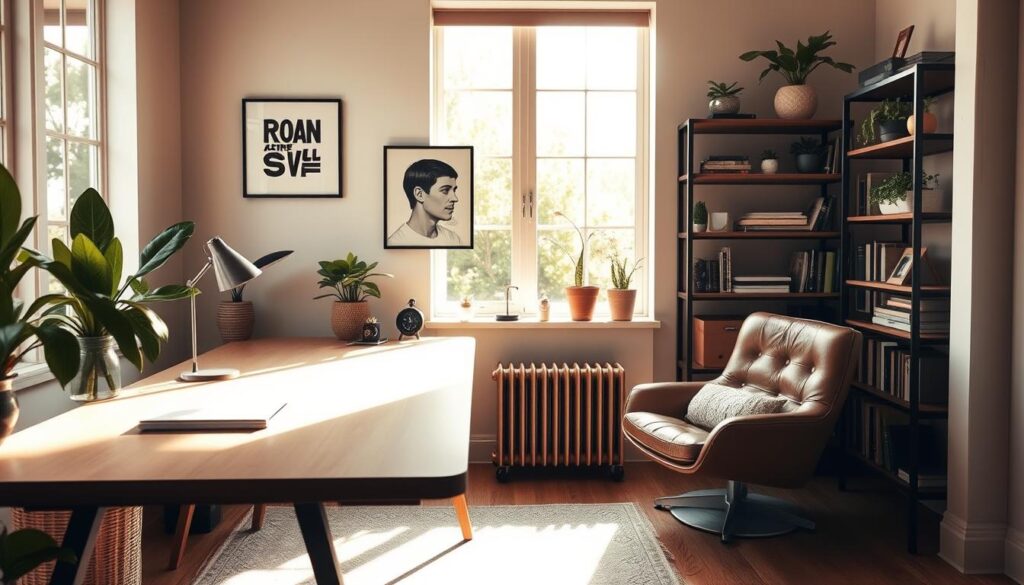
If you love art, hang your favorite pieces or prints. This adds beauty and makes your space feel more like home.
Incorporating Inspiring Artwork
Adding inspiring artwork can really boost your motivation and creativity. Pick pieces that speak to you, like motivational quotes or serene landscapes. Minimalist home office inspiration often uses simple designs, which can be very effective too.
| Artwork Type | Effect on Workspace |
|---|---|
| Motivational Quotes | Boosts motivation and focus |
| Abstract Art | Stimulates creativity |
| Serene Landscapes | Promotes calmness and reduces stress |
Utilizing Plants for a Fresh Atmosphere
Using plants in your home office is a great way to make it your own. Plants clean the air, look good, and make you feel better. Start with easy plants like succulents or snake plants if you’re new to gardening.
By adding these touches, you can make a home office that’s both functional and personal. This space will be more inviting, inspiring, and perfect for getting work done.
Tech Essentials for Modern Home Offices
A modern home office needs more than just a comfy spot to work. It also needs the right tech to stay on top. As we work from home more, having the right gadgets boosts our productivity and work experience.
Must-Have Gadgets and Equipment
To make a home office efficient, we must choose the right tech. Some key items include:
- A reliable and fast computer or laptop
- A high-quality monitor for multitasking
- A comfortable and precise wireless mouse and keyboard
- A noise-canceling headset for video calls
- A multifunctional printer and scanner
These gadgets make our work easier and help us stay organized and focused.
Setting Up Efficient Connectivity
Good connectivity is key for a productive home office. This means:
- A fast and reliable internet connection
- A router that can handle multiple devices
- A network switch for expanded connectivity
- A quality Wi-Fi extender to ensure coverage throughout the home
With a strong network, we can have smooth communication and data transfer. This makes our work flow better.
Organizing Cables and Accessories
A tidy workspace is not just nice to look at; it’s also more useful. To keep things neat, we should organize our cables and accessories well. Here are some tips:
- Using cable ties or zip ties to keep cables together
- Investing in a cable management box or tray
- Labeling cables for easy identification
- Utilizing a docking station to consolidate peripherals
By organizing our workspace, we can cut down on distractions. This boosts our productivity.
Creating a Distraction-Free Environment
To reach peak productivity, it’s key to cut down on distractions in your home office. A well-thought-out workspace helps you stay on track and avoid interruptions. This leads to higher work quality and efficiency.
Soundproofing Tips and Tricks
Soundproofing is vital for a distraction-free home office. Here are some tips to lower noise:
- Use acoustic panels or sound-absorbing materials on walls and ceilings.
- Install door sweeps or seals to prevent sound leakage.
- Place area rugs and thick curtains to absorb sound.
These soundproofing strategies can greatly reduce outside noise. This makes your workspace quieter.
Minimizing Visual Clutter
A clean environment is key for focus. To cut down on visual clutter:
- Keep your workspace organized and tidy.
- Use storage solutions such as shelves and drawers.
- Avoid placing too many decorative items on your desk.
Reducing visual clutter boosts your concentration and productivity.
Managing Interruptions from Family
Handling interruptions from family can be tough. Here are some tips to lessen distractions:
| Strategy | Description | Benefit |
|---|---|---|
| Communicate your work hours | Tell your family about your work schedule. | Reduces unexpected interruptions. |
| Set boundaries | Make clear boundaries with your family. | Helps keep a distraction-free environment. |
| Create a quiet workspace | Choose a quiet spot for your home office. | Improves focus and productivity. |
By using these strategies, you can handle interruptions better. This keeps your home office productive.
Examples of Effective Home Office Designs
Let’s look at some inspiring home office designs that are both stylish and functional. These designs can really boost our productivity and work experience.
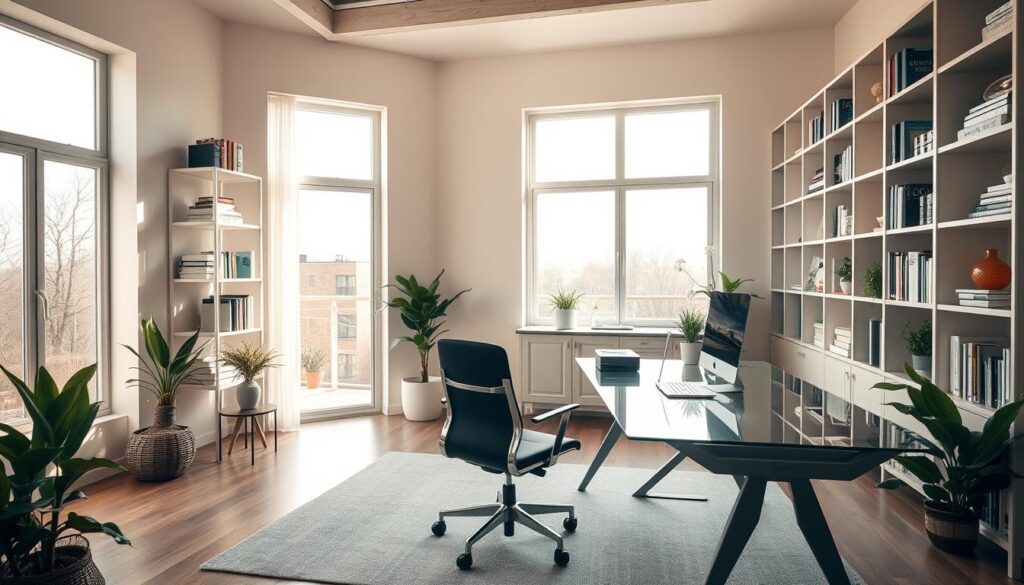
Small Space Solutions
If you have a small space, planning is key. Multi-functional furniture is essential. For example, a desk with storage keeps things tidy.
Using vertical space is also smart for small offices. Shelves or wall-mounted cabinets offer storage without taking up floor space.
- Choose furniture that does more than one thing.
- Use light colors to make the space look bigger.
- Think about a foldable desk or wall-mounted work surface.
Stylish Combinations of Work and Relaxation
Mixing work and relaxation areas makes for a great home office. Adding a cozy reading nook or a sofa that’s also a guest bed works well.
For a smooth transition between work and chill time, use a consistent color palette. This creates a calm and unified space.
| Design Element | Work Area | Relaxation Area |
|---|---|---|
| Furniture | Ergonomic desk and chair | Comfortable sofa or armchair |
| Lighting | Task lighting for focus | Soft, ambient lighting |
| Color | Neutral tones for concentration | Calming colors like blue or green |
Case Studies of Successful Designs
Looking at successful home office designs can give us great ideas. For instance, a well-designed home office might have natural light, simple decor, and ergonomic furniture.
Another good idea is using tech to boost productivity. This could include smart storage, fast internet, and noise-cancelling headphones.
By studying these examples and applying good design principles, you can make a home office that’s both useful and inspiring.
Maintaining Organization in Your Home Office
To stay productive, keeping your home office tidy is key. A messy desk can make your mind feel cluttered, making it hard to focus. We’ll look at ways to stay organized, from using time management tools to decluttering.
Time Management Tools and Techniques
Good time management is crucial for a productive home office. Tools like calendars, planners, and apps can keep you on schedule. For example, digital calendars like Google Calendar let you plan tasks and set reminders. Project management tools like Trello help organize projects into smaller tasks.
Techniques like the Pomodoro Technique can also boost productivity. It involves working in focused 25-minute bursts with 5-minute breaks. Combining the right tools with these techniques can create a system that suits you.
Digital vs. Physical Organization
The debate between digital and physical organization is ongoing. Digital organization is great because you can access your stuff from anywhere and sync it across devices. But, physical organization methods, like paper planners and file cabinets, offer a hands-on experience that some prefer.
Often, the best approach is a mix of both digital and physical methods. For instance, you might use a digital calendar for scheduling but keep a physical planner for jotting down notes and ideas.
Regular Decluttering Strategies
Regular decluttering is essential for a tidy home office. Set aside time each week to clean up your space. This can mean filing documents, dusting your gear, and getting rid of things you don’t need.
Try the “one touch rule” for paperwork: handle each piece once, either by filing it, throwing it away, or taking action. This can greatly reduce clutter and make your workspace more efficient.
By using these strategies, you can keep your home office organized. It will be a place where you can be productive and creative.
Staying Inspired in Your Workspace
Keeping your home office inspiring is all about design and personal touches. A well-designed space boosts productivity and sparks creativity. It keeps you motivated too.
Creating a Vision Board
A vision board is a great way to stay inspired. It shows your goals and dreams. To make one, gather a board, magazines, scissors, and decorations you like.
- Cut out images and words that match your goals.
- Arrange them on your board in a way that feels meaningful to you.
- Hang your vision board in a place where you’ll see it daily, such as above your desk.
This visual reminder of your goals keeps you focused and motivated. It’s a simple yet effective way to stay inspired at work.
Setting Up a Reward System
Creating a reward system is another way to stay inspired. Acknowledging and rewarding your achievements keeps you positive and motivated.
| Task | Reward |
|---|---|
| Completing a challenging project | A favorite meal or a night out |
| Meeting a tight deadline | A short break or a fun activity |
Setting up a reward system helps you feel accomplished. It also encourages good work habits.
Incorporating Ideas from Successful Home Offices
Getting inspiration from successful home offices is helpful. Think about adding stylish home office furniture or modern design to your space.
For example, you might:
- Use ergonomic furniture to enhance comfort and productivity.
- Incorporate plants or artwork to add visual interest.
- Utilize modern technology to streamline your work processes.
By using these ideas, you can make your home office inspiring and functional.
The Future of Home Office Interiors
Our home office interiors are changing with the times. They need to adapt to new trends and be eco-friendly. This makes our workspaces both creative and sustainable.
Emerging Trends
New trends are making home offices better. We’re seeing more tech, green design, and flexible spaces. These changes make our offices look good and feel great.
Sustainable Choices
Choosing eco-friendly options is key. This includes green furniture and energy-saving lights. It helps our offices be good for the planet and for us.
Adapting to Change
Our home offices must keep up with work changes. We need designs that can change and new tech to improve our spaces. This keeps our work areas fresh and productive.

